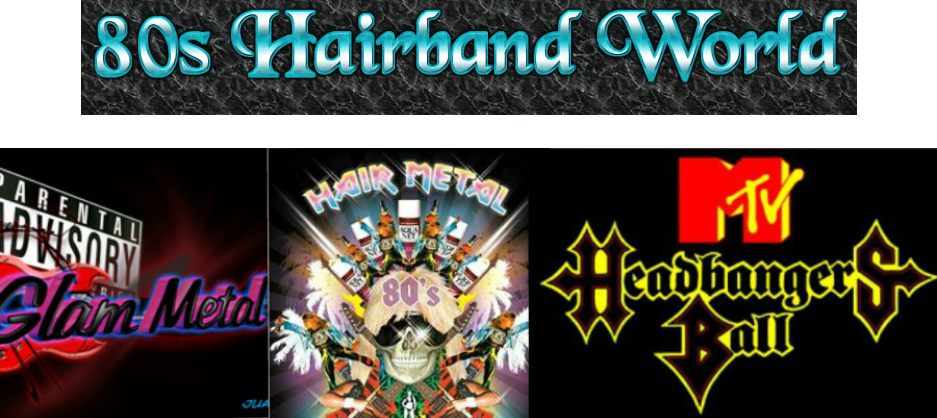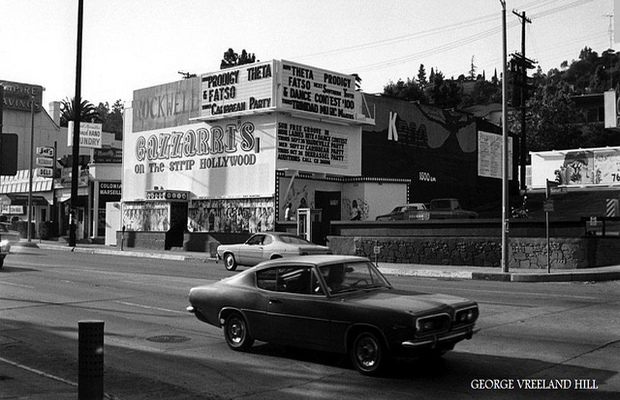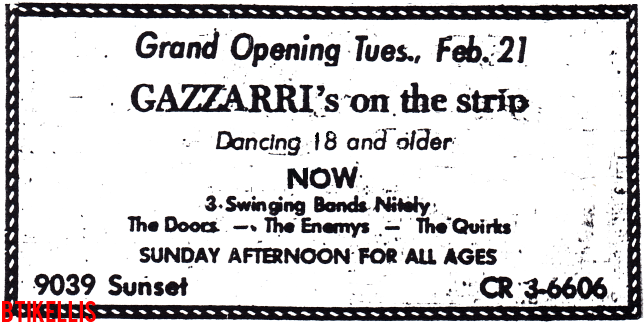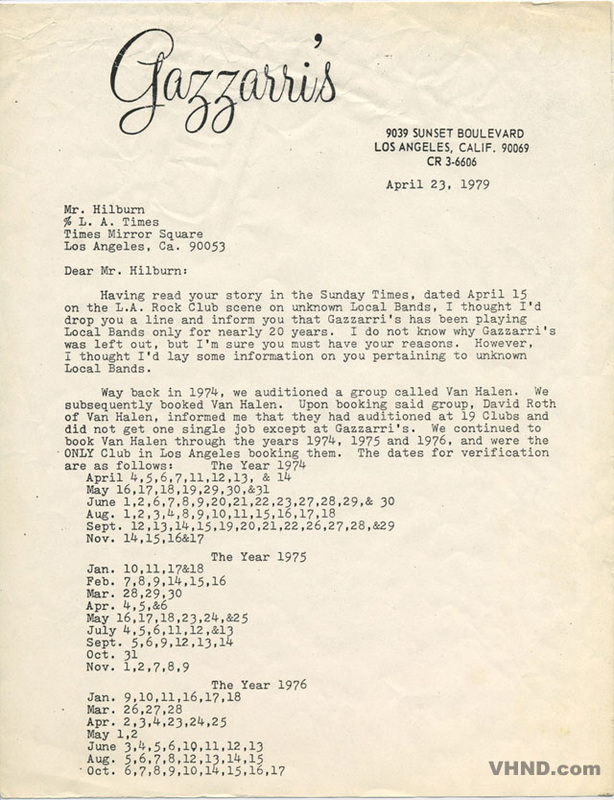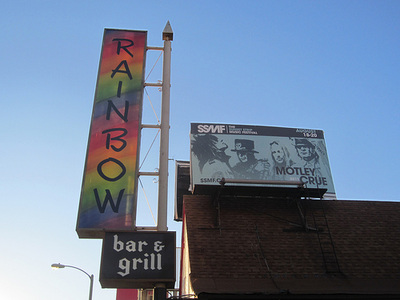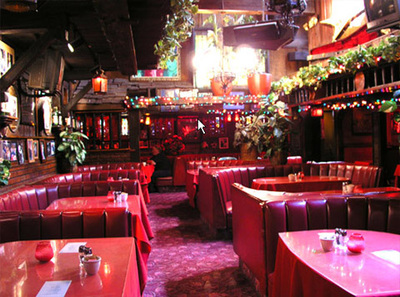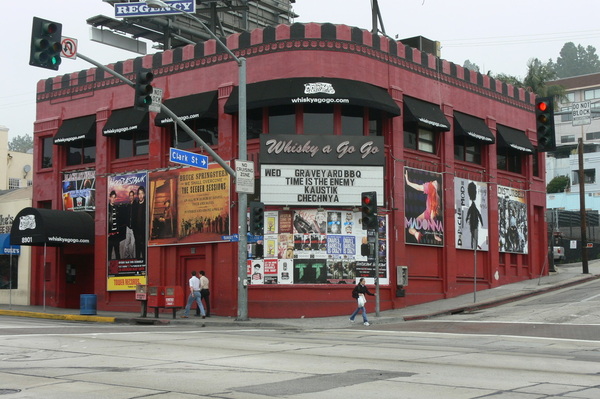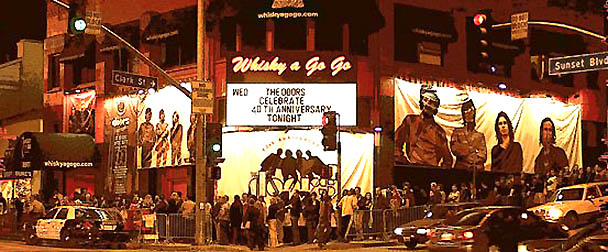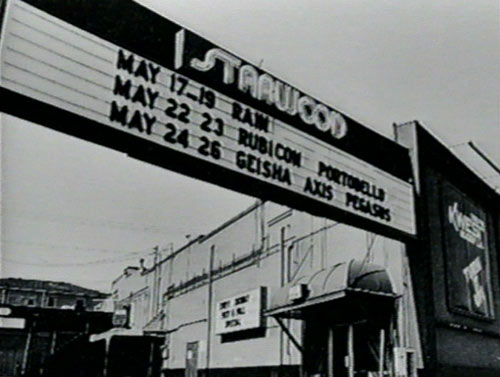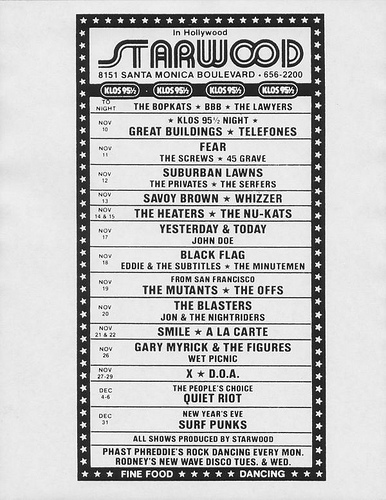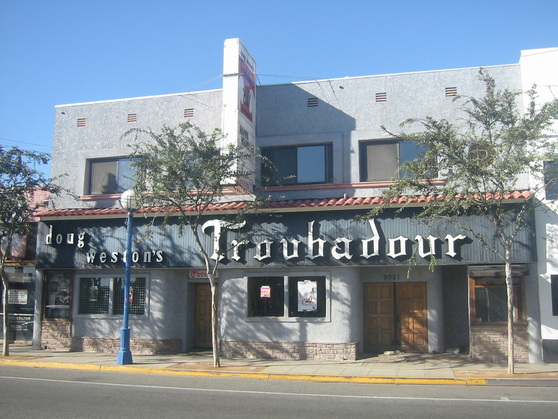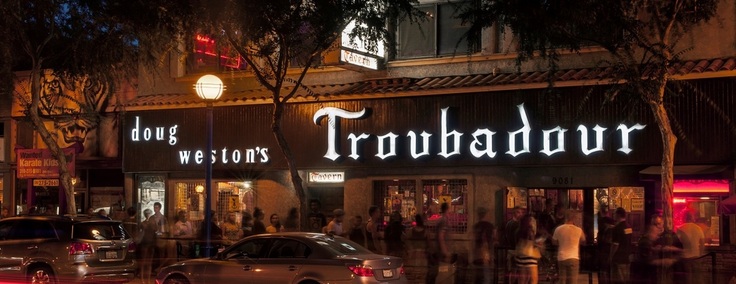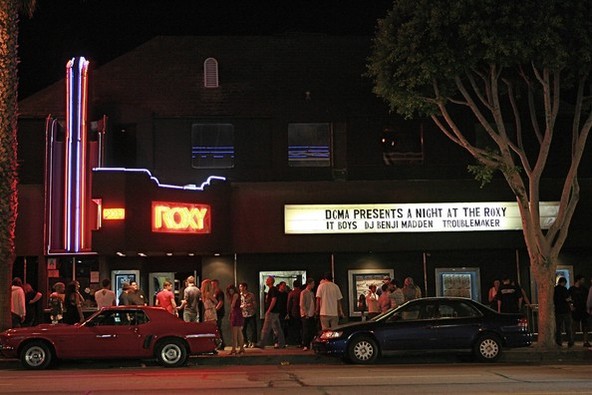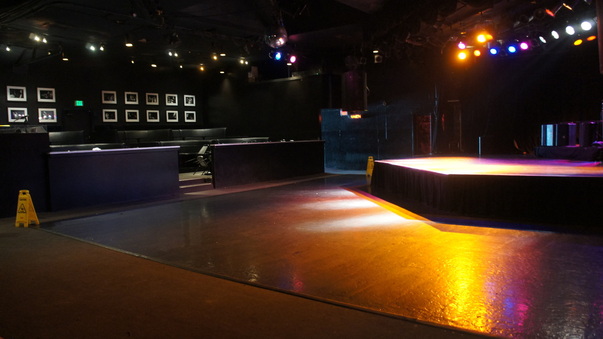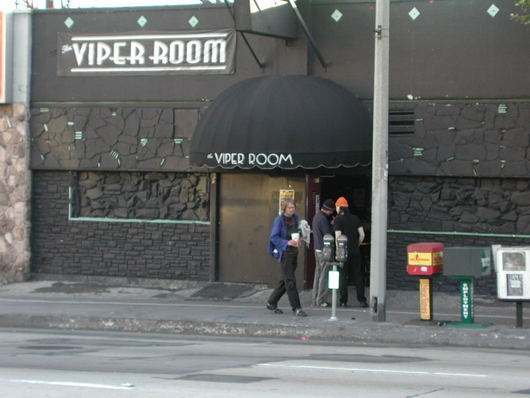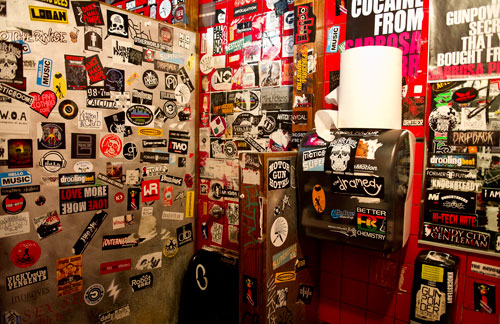L.A Clubs from Sunset Strip
Gazzarri's
Gazzarri's was a nightclub on the Sunset Strip in West Hollywood, California, United States. It is most notable as the location where The Doors and Van Halen were featured house bands for long stretches before being discovered. It was also the LA club featured in Huey Lewis and the News MTV video for their hit "The Heart of Rock and Roll."
Along with The Roxy Theatre, The Whisky a Go Go, The Troubadour, The Starwood, and other nearby nightclubs, it was a staple of the Los Angeles music scene in the 1960s, 1970s and 1980s and early 90's. Some other bands that played at Gazzarri's either prior to or during their mainstream success include Johnny Rivers, The Go-Go's, Tina Turner, Southgang, Sonny and Cher, Ratt, Cinderella, Chicano rock band Renegade, punk band X, Victor Flamingo, Quiet Riot, Stryper, Mötley Crüe, Poison, Guns N' Roses, Warrant, Faster Pussycat, and Canadian rockers Hollywood Trash. Other notable local Los Angeles area bands to play there included Redd Kross, Brunette, Shark Island, Hurricane (band), Page 3, Taz, Tuff, Foxx, Storyteller, Reinkus Tide, D'Molls, Cold Shot, LEGACY,TRAMP and Pretty Boy Floyd, and bands that never made it like Odin, managed by Bill Gazzari himself, and featured in The Decline of Western Civilization Part II: The Metal Years, bands such as Salute, Shocktop, and Broken Cherry. Many giant hand-painted pictures of these bands adorned the side of the club's outside wall for many years.
Along with The Roxy Theatre, The Whisky a Go Go, The Troubadour, The Starwood, and other nearby nightclubs, it was a staple of the Los Angeles music scene in the 1960s, 1970s and 1980s and early 90's. Some other bands that played at Gazzarri's either prior to or during their mainstream success include Johnny Rivers, The Go-Go's, Tina Turner, Southgang, Sonny and Cher, Ratt, Cinderella, Chicano rock band Renegade, punk band X, Victor Flamingo, Quiet Riot, Stryper, Mötley Crüe, Poison, Guns N' Roses, Warrant, Faster Pussycat, and Canadian rockers Hollywood Trash. Other notable local Los Angeles area bands to play there included Redd Kross, Brunette, Shark Island, Hurricane (band), Page 3, Taz, Tuff, Foxx, Storyteller, Reinkus Tide, D'Molls, Cold Shot, LEGACY,TRAMP and Pretty Boy Floyd, and bands that never made it like Odin, managed by Bill Gazzari himself, and featured in The Decline of Western Civilization Part II: The Metal Years, bands such as Salute, Shocktop, and Broken Cherry. Many giant hand-painted pictures of these bands adorned the side of the club's outside wall for many years.
Rainbow BAr and Grill
The Rainbow Bar and Grill is a bar and restaurant on the Sunset Strip in West Hollywood, California, United States adjacent to the border of Beverly Hills, California. Its address is 9015 Sunset Boulevard.The bottom level of the building is the restaurant, The Rainbow Bar and Grill. Upstairs is an exclusive club called "Over the Rainbow", which consists of a full bar, dance floor, and a DJ booth. The restaurant is next to The Roxy Theatre and The Key Club.
The restaurant was founded in early 1972 by Elmer Valentine, Lou Adler, Mario Maglieri and others, opening on April 16, 1972 with a party for Elton John. At the time, the word "rainbow" signified peace and freedom. It quickly became known as a hangout for celebrities of all types. John Belushi ate his last meal (lentil soup) at table #16. For many years, the owner was Mario Maglieri.
Before becoming the Rainbow, the restaurant was the Villa Nova restaurant, which was originally owned by film director Vincente Minnelli, at the time married to Judy Garland. Joe DiMaggio and Marilyn Monroe met at the restaurant on a blind date in 1952.
The Rainbow became known as a hangout for rock musicians and their groupies. Notable regulars at the Rainbow in this period include Lemmy Kilmister, John Lennon, Keith Moon, Micky Dolenz, Grace Slick, Ringo Starr, Neil Diamond, Robert Plant, Tony Iommi, Ronnie James Dio, Alice Cooper, Lizzy Valentine and many others. Elvis Presley was known to have occasionally visited the Rainbow. The famous group of musicians called The Hollywood Vampires made the Rainbow their home away from home in the early 1970s.
Los Angeles songwriter Warren Zevon referenced the scene at the Rainbow in the last verse of his 1976 song "Poor Poor Pitiful Me."
The musical group Rainbow was named after this club.
The track "Rainbow Bar & Grill" from the Cheech & Chong album Let's Make a New Dope Deal takes place in the bar and restaurant.
Producer Kim Fowley used to hangout at the Rainbow, especially in 1975, when he formed the all-girl group The Runaways.
As musical trends on the Strip changed towards heavy metal in the 1980s, the Rainbow followed suit. Members of Mötley Crüe, Poison, and Guns N' Roses frequented the bar. It was mentioned in a number of songs, such as "Sunset and Babylon" by W.A.S.P., "Vampire" by L.A. Guns and "Peach Kelli Pop" by Redd Kross, and featured in the videos of "November Rain", "Estranged" and "Don't Cry" by Guns N' Roses and also, although briefly, "Rock Out" by Motörhead .
Anthony Kiedis of the Red Hot Chili Peppers noted in his book Scar Tissue that he often sat with his father, Blackie Dammett, at the club along with various members of bands such as Led Zeppelin. Often the waitresses and bartenders were groupies as well as those who frequented the establishment. In Pamela Des Barres' book, Let's Spend the Night Together, the author commented that as an employee in the early 1980s she met a number of celebrities including Billy Idol.
In the early nineties, a tradition of hanging out at The Rainbow after a show was carried on by Glam Metal bands like Peppermint Creeps, The Zeros, Alley Cat Scratch, Slamhound, No Sympathy, and Big Bang Babies.
The restaurant was founded in early 1972 by Elmer Valentine, Lou Adler, Mario Maglieri and others, opening on April 16, 1972 with a party for Elton John. At the time, the word "rainbow" signified peace and freedom. It quickly became known as a hangout for celebrities of all types. John Belushi ate his last meal (lentil soup) at table #16. For many years, the owner was Mario Maglieri.
Before becoming the Rainbow, the restaurant was the Villa Nova restaurant, which was originally owned by film director Vincente Minnelli, at the time married to Judy Garland. Joe DiMaggio and Marilyn Monroe met at the restaurant on a blind date in 1952.
The Rainbow became known as a hangout for rock musicians and their groupies. Notable regulars at the Rainbow in this period include Lemmy Kilmister, John Lennon, Keith Moon, Micky Dolenz, Grace Slick, Ringo Starr, Neil Diamond, Robert Plant, Tony Iommi, Ronnie James Dio, Alice Cooper, Lizzy Valentine and many others. Elvis Presley was known to have occasionally visited the Rainbow. The famous group of musicians called The Hollywood Vampires made the Rainbow their home away from home in the early 1970s.
Los Angeles songwriter Warren Zevon referenced the scene at the Rainbow in the last verse of his 1976 song "Poor Poor Pitiful Me."
The musical group Rainbow was named after this club.
The track "Rainbow Bar & Grill" from the Cheech & Chong album Let's Make a New Dope Deal takes place in the bar and restaurant.
Producer Kim Fowley used to hangout at the Rainbow, especially in 1975, when he formed the all-girl group The Runaways.
As musical trends on the Strip changed towards heavy metal in the 1980s, the Rainbow followed suit. Members of Mötley Crüe, Poison, and Guns N' Roses frequented the bar. It was mentioned in a number of songs, such as "Sunset and Babylon" by W.A.S.P., "Vampire" by L.A. Guns and "Peach Kelli Pop" by Redd Kross, and featured in the videos of "November Rain", "Estranged" and "Don't Cry" by Guns N' Roses and also, although briefly, "Rock Out" by Motörhead .
Anthony Kiedis of the Red Hot Chili Peppers noted in his book Scar Tissue that he often sat with his father, Blackie Dammett, at the club along with various members of bands such as Led Zeppelin. Often the waitresses and bartenders were groupies as well as those who frequented the establishment. In Pamela Des Barres' book, Let's Spend the Night Together, the author commented that as an employee in the early 1980s she met a number of celebrities including Billy Idol.
In the early nineties, a tradition of hanging out at The Rainbow after a show was carried on by Glam Metal bands like Peppermint Creeps, The Zeros, Alley Cat Scratch, Slamhound, No Sympathy, and Big Bang Babies.
Whisky a go-go
Whisky a Go Go is a nightclub in West Hollywood, California, United States. It is located at 8901 Sunset Boulevard, on the Sunset Strip.
In 1958, the first Whisky a Go-Go in North America opened in Chicago, Illinois, on the corner of Rush Street and Chestnut Streets. It has been called the first real American discothèque. A franchise was opened in 1966 on M Street in the Georgetown section of Washington, D.C., by restaurateur Jacques Vivien.
It owes its name to the first discothèque, the 'Whisky à Go-Go', established in Paris in 1947 by Paul Pacine.
The Sunset Strip Whisky was founded by Elmer Valentine, Phil Tanzini, Shelly Davis, and attorney Theodore Flier and opened on January 16, 1964. In 1972, Valentine, Lou Adler, Mario Maglieri and others started the Rainbow Bar & Grill on the Sunset Strip. In 1966, Valentine, Adler and others founded The Roxy Theatre. Lou Adler bought into the Whisky in the late 1970s. Valentine sold his interest in the Whisky a Go Go in the 1990s but retained an ownership in the Rainbow Bar & Grill and the Roxy Theatre until his death in December 2008.
Though the club was billed as a discothèque, suggesting that it offered only recorded music, the Whisky a Go Go opened with a live band led by Johnny Rivers and a short-skirted female DJ Rhonda Lane, spinning records between sets from a suspended cage at the right of the stage.
The Whisky a Go Go was one of the places that popularized go-go dancing. Elmer Valentine, in a 2006 Vanity Fair article, recalled arranging to have a female DJ play records between Rivers' sets so patrons could continue dancing. But because there was not enough room on the floor for a DJ booth, he had a glass-walled booth mounted high above the floor.
A contest was held for the girl DJ job but when the young winner called Valentine on the night of the opening tearfully said her mother forbade her from doing it, Valentine recruited the club's cigarette girl, Patty Brockhurst. Valentine quickly hired two more girl dancers, one of whom, Joanna Labean, designed the official go-go-girl costume of fringed dress and white boots.
Rivers rode the Whisky-born go-go craze to national fame with records recorded partly "live at the Whisky." In addition, the Miracles recorded the song "Going to a Go-Go" in 1966 (which was covered in 1982 by The Rolling Stones), and Whisky a Go Go franchises sprang up all over the country.
In 1966, the Whisky was one of the centers of what fans call the Sunset Strip police riots.
Arguably, the rock and roll scene in Los Angeles was born when the Whisky started operation.
In 1958, the first Whisky a Go-Go in North America opened in Chicago, Illinois, on the corner of Rush Street and Chestnut Streets. It has been called the first real American discothèque. A franchise was opened in 1966 on M Street in the Georgetown section of Washington, D.C., by restaurateur Jacques Vivien.
It owes its name to the first discothèque, the 'Whisky à Go-Go', established in Paris in 1947 by Paul Pacine.
The Sunset Strip Whisky was founded by Elmer Valentine, Phil Tanzini, Shelly Davis, and attorney Theodore Flier and opened on January 16, 1964. In 1972, Valentine, Lou Adler, Mario Maglieri and others started the Rainbow Bar & Grill on the Sunset Strip. In 1966, Valentine, Adler and others founded The Roxy Theatre. Lou Adler bought into the Whisky in the late 1970s. Valentine sold his interest in the Whisky a Go Go in the 1990s but retained an ownership in the Rainbow Bar & Grill and the Roxy Theatre until his death in December 2008.
Though the club was billed as a discothèque, suggesting that it offered only recorded music, the Whisky a Go Go opened with a live band led by Johnny Rivers and a short-skirted female DJ Rhonda Lane, spinning records between sets from a suspended cage at the right of the stage.
The Whisky a Go Go was one of the places that popularized go-go dancing. Elmer Valentine, in a 2006 Vanity Fair article, recalled arranging to have a female DJ play records between Rivers' sets so patrons could continue dancing. But because there was not enough room on the floor for a DJ booth, he had a glass-walled booth mounted high above the floor.
A contest was held for the girl DJ job but when the young winner called Valentine on the night of the opening tearfully said her mother forbade her from doing it, Valentine recruited the club's cigarette girl, Patty Brockhurst. Valentine quickly hired two more girl dancers, one of whom, Joanna Labean, designed the official go-go-girl costume of fringed dress and white boots.
Rivers rode the Whisky-born go-go craze to national fame with records recorded partly "live at the Whisky." In addition, the Miracles recorded the song "Going to a Go-Go" in 1966 (which was covered in 1982 by The Rolling Stones), and Whisky a Go Go franchises sprang up all over the country.
In 1966, the Whisky was one of the centers of what fans call the Sunset Strip police riots.
Arguably, the rock and roll scene in Los Angeles was born when the Whisky started operation.
Starwood
The Starwood Club was a popular nightclub in West Hollywood, California from early in 1973 to 1979. Many punk bands and heavy metal bands started their careers playing at the Starwood.
The Starwood Nightclub and music venue was located on the northwest corner of Santa Monica Blvd. and North Crescent Heights Blvd. It had been a fashionable jazz nightclub called PJ's in the 1960s, which attracted a large number of film and TV personalities and some old school jazz musicians. PJ's hosted such acts as The Bobby Fuller Four, The Standells, Rufus Thomas, and Trini Lopez who recorded live albums there. It was managed by Elmer Valentine before he left to found the Whisky A Go-Go.
By 1966 PJ's had been bought by an organized crime figure, Eddie Nash and reputed organized crime figure Dominic Lucci, and was managed by Gary Fontenot (not an organized crime figure) for many years. In 1973, after Nash bought out Lucci's ownership interest in the club, it became The Starwood. It closed in 1981, torn down by the City, after too many citations for underage drinking and noise abatement issues. Before it was demolished it caught fire, though not burning totally. This occurred while unexplained fires befell other Nash-owned properties at the time. Subsequently the structure was torn down, and a mini-mall was built on the site.
he Starwood was highly instrumental in the careers of many regional bands and artists including; A La Carte, Black Flag, The Germs, The Dickies, The Go-Go's, FEAR, Circle Jerks, The Blasters, The Knack, The Kats/The Nu Kats, The Mau-Mau's, Sister (band), Circus Circus (band) (going on to become W.A.S.P.) The Motels, The Pop, Foxtrot, Windance, The Plimsouls, The Quick, The Plugz, Snow, SMILE, Suburban Lawns, Quiet Riot, The Runaways, Pegasus,
Some of the acts from outside of California who played at the Starwood include; The Damned, Dokken, Devo, The Jam, Cheap Trick, The Ramones, Dead Boys, The Stranglers, AC/DC, Slade, Vince Vance & the Valiants, Rush, and The Fleshtones.
Starwood was mentioned in the Red Hot Chili Pepper's song Deep Kick. "Had to sneak into the Starwood" The club is also mentioned (along with Madam Wong's and the Whiskey A Go-Go) in the title track from Frank Zappa's 1981 album, Tinseltown Rebellion
The Starwood Nightclub and music venue was located on the northwest corner of Santa Monica Blvd. and North Crescent Heights Blvd. It had been a fashionable jazz nightclub called PJ's in the 1960s, which attracted a large number of film and TV personalities and some old school jazz musicians. PJ's hosted such acts as The Bobby Fuller Four, The Standells, Rufus Thomas, and Trini Lopez who recorded live albums there. It was managed by Elmer Valentine before he left to found the Whisky A Go-Go.
By 1966 PJ's had been bought by an organized crime figure, Eddie Nash and reputed organized crime figure Dominic Lucci, and was managed by Gary Fontenot (not an organized crime figure) for many years. In 1973, after Nash bought out Lucci's ownership interest in the club, it became The Starwood. It closed in 1981, torn down by the City, after too many citations for underage drinking and noise abatement issues. Before it was demolished it caught fire, though not burning totally. This occurred while unexplained fires befell other Nash-owned properties at the time. Subsequently the structure was torn down, and a mini-mall was built on the site.
he Starwood was highly instrumental in the careers of many regional bands and artists including; A La Carte, Black Flag, The Germs, The Dickies, The Go-Go's, FEAR, Circle Jerks, The Blasters, The Knack, The Kats/The Nu Kats, The Mau-Mau's, Sister (band), Circus Circus (band) (going on to become W.A.S.P.) The Motels, The Pop, Foxtrot, Windance, The Plimsouls, The Quick, The Plugz, Snow, SMILE, Suburban Lawns, Quiet Riot, The Runaways, Pegasus,
Some of the acts from outside of California who played at the Starwood include; The Damned, Dokken, Devo, The Jam, Cheap Trick, The Ramones, Dead Boys, The Stranglers, AC/DC, Slade, Vince Vance & the Valiants, Rush, and The Fleshtones.
Starwood was mentioned in the Red Hot Chili Pepper's song Deep Kick. "Had to sneak into the Starwood" The club is also mentioned (along with Madam Wong's and the Whiskey A Go-Go) in the title track from Frank Zappa's 1981 album, Tinseltown Rebellion
Troubadour
The Troubadour is a nightclub located in West Hollywood, California, USA, at 9081 Santa Monica Boulevard just east of Doheny Drive and the border of Beverly Hills. It was opened in 1957 by Doug Weston as a coffee house on La Cienega Boulevard, then moved to its current location shortly after opening and has remained open continuously since. It was a major center for folk music in the 1960s, and subsequently for singer-songwriters and rock.
The Troubadour played an important role in the careers of Elton John, Linda Ronstadt, James Taylor, the Eagles, The Byrds, Love, Joni Mitchell, Hoyt Axton, Carole King, Bonnie Raitt, J.D. Souther, Jackson Browne, Van Morrison, Buffalo Springfield and other prominent and successful performers, who played performances there establishing their future fame. In 1962, comedian Lenny Bruce was arrested on obscenity charges for using the word "schmuck" on stage; one of the arresting officers was Sherman Block, who would later become Los Angeles County Sheriff. On August 25, 1970, Neil Diamond (who had just recorded his first live album at the Troubadour) introduced Elton John, who performed his first show in the United States at the Troubadour. In 1974, John Lennon and his friend Harry Nilsson were ejected from the club for drunkenly heckling the Smothers Brothers. Randy Newman started out at the club and comics Cheech & Chong and Steve Martin were discovered there. In 1975, Elton John returned to do a series of special anniversary concerts. In November 2007, James Taylor and Carole King played a series of concerts commemorating the nightclub's 50th anniversary and reuniting the two from their 1970 performance.
Other alumni include Fleetwood Mac, Rod Stewart, Carly Simon, George Carlin, Michael Nesmith, Rickie Lee Jones, Paramore, The Tragically Hip, Sloan, Lenny Bruce, Bette Midler, Leo Kottke, Bruce Springsteen, the Pointer Sisters, Liza Minnelli, Half Way Home, Sheryl Crow, Natalie Maines, Karla Bonoff, Al Stewart, Kyle Vincent, Waylon Jennings, Tom Waits, Pavement, Rise Against, Leonard Cohen, Tommy Cody, Roberta Flack, Ramblin' Jack Elliot, Paul Sykes, Donny Hathaway, Arlo Guthrie, Darren Criss, The Spats and Republic of Loose.
The Troubadour featured new wave and punk in the late 1970s and early 1980s, and became virtually synonymous with heavy metal and glam bands like Mötley Crüe, Candy, Guns N' Roses, Poison, Warrant and W.A.S.P. in the 1980s. Guns N' Roses played their first show at the Troubadour, and were also discovered by a David Geffen A&R representative at the club. During the Glam/ Metal years Gina Barsamian was the primary booking agent for the club. There is a variety of styles of music played at the Troubadour to the present day and it continues to be one of Hollywood's favorite and most respected places to see live music.
The Troubadour played an important role in the careers of Elton John, Linda Ronstadt, James Taylor, the Eagles, The Byrds, Love, Joni Mitchell, Hoyt Axton, Carole King, Bonnie Raitt, J.D. Souther, Jackson Browne, Van Morrison, Buffalo Springfield and other prominent and successful performers, who played performances there establishing their future fame. In 1962, comedian Lenny Bruce was arrested on obscenity charges for using the word "schmuck" on stage; one of the arresting officers was Sherman Block, who would later become Los Angeles County Sheriff. On August 25, 1970, Neil Diamond (who had just recorded his first live album at the Troubadour) introduced Elton John, who performed his first show in the United States at the Troubadour. In 1974, John Lennon and his friend Harry Nilsson were ejected from the club for drunkenly heckling the Smothers Brothers. Randy Newman started out at the club and comics Cheech & Chong and Steve Martin were discovered there. In 1975, Elton John returned to do a series of special anniversary concerts. In November 2007, James Taylor and Carole King played a series of concerts commemorating the nightclub's 50th anniversary and reuniting the two from their 1970 performance.
Other alumni include Fleetwood Mac, Rod Stewart, Carly Simon, George Carlin, Michael Nesmith, Rickie Lee Jones, Paramore, The Tragically Hip, Sloan, Lenny Bruce, Bette Midler, Leo Kottke, Bruce Springsteen, the Pointer Sisters, Liza Minnelli, Half Way Home, Sheryl Crow, Natalie Maines, Karla Bonoff, Al Stewart, Kyle Vincent, Waylon Jennings, Tom Waits, Pavement, Rise Against, Leonard Cohen, Tommy Cody, Roberta Flack, Ramblin' Jack Elliot, Paul Sykes, Donny Hathaway, Arlo Guthrie, Darren Criss, The Spats and Republic of Loose.
The Troubadour featured new wave and punk in the late 1970s and early 1980s, and became virtually synonymous with heavy metal and glam bands like Mötley Crüe, Candy, Guns N' Roses, Poison, Warrant and W.A.S.P. in the 1980s. Guns N' Roses played their first show at the Troubadour, and were also discovered by a David Geffen A&R representative at the club. During the Glam/ Metal years Gina Barsamian was the primary booking agent for the club. There is a variety of styles of music played at the Troubadour to the present day and it continues to be one of Hollywood's favorite and most respected places to see live music.
THe Roxy
The Roxy Theatre (often just The Roxy) is a famous nightclub, on the Sunset Strip, in West Hollywood, California. The Roxy is owned by Lou Adler and Adler's son, Nic, who operates the club.
The Roxy was opened on September 23, 1973, by Elmer Valentine and Lou Adler, along with original partners David Geffen, Elliot Roberts and Peter Asher. They took over the building previously occupied by a strip club owned by Chuck Landis called the Largo. (Adler was also responsible for bringing the stage play The Rocky Horror Show to the United States, and it opened its first American run at The Roxy Theatre in 1974, before it was made into the movie The Rocky Horror Picture Show the next year.)
Neil Young and his band The Santa Monica Flyers played the Roxy for the first week it was open. Only three months later, the original Genesis lineup with Peter Gabriel played several consecutive days at the Roxy, a run that some band members and many fans consider to be amongst their finest performances (due partially to the intimate atmosphere and good acoustics of the venue, as well as the legendary reputation of "Hollywood" amongst performers around the world).
Paul Reubens, then a struggling comedian, introduced his Pee-wee Herman character in a raunchy revue here in 1981 that included other aspiring comics including Phil Hartman and Elayne Boosler.
The small On The Rox bar above the club has hosted a wide variety of debauchery in its history. The bar was a regular hangout for John Lennon, Harry Nilsson, Alice Cooper and Keith Moon during Lennon's "lost weekend" in 1973-74 and hosted parties arranged by Heidi Fleiss in the 1980s.
In 1984, Ratt recorded the video for their hit single Back For More from the album Out of the Cellar at The Roxy. The band has stated that The Roxy is one of their favorite clubs to perform at. Below is Ratt's video "Back For More"
The Roxy was opened on September 23, 1973, by Elmer Valentine and Lou Adler, along with original partners David Geffen, Elliot Roberts and Peter Asher. They took over the building previously occupied by a strip club owned by Chuck Landis called the Largo. (Adler was also responsible for bringing the stage play The Rocky Horror Show to the United States, and it opened its first American run at The Roxy Theatre in 1974, before it was made into the movie The Rocky Horror Picture Show the next year.)
Neil Young and his band The Santa Monica Flyers played the Roxy for the first week it was open. Only three months later, the original Genesis lineup with Peter Gabriel played several consecutive days at the Roxy, a run that some band members and many fans consider to be amongst their finest performances (due partially to the intimate atmosphere and good acoustics of the venue, as well as the legendary reputation of "Hollywood" amongst performers around the world).
Paul Reubens, then a struggling comedian, introduced his Pee-wee Herman character in a raunchy revue here in 1981 that included other aspiring comics including Phil Hartman and Elayne Boosler.
The small On The Rox bar above the club has hosted a wide variety of debauchery in its history. The bar was a regular hangout for John Lennon, Harry Nilsson, Alice Cooper and Keith Moon during Lennon's "lost weekend" in 1973-74 and hosted parties arranged by Heidi Fleiss in the 1980s.
In 1984, Ratt recorded the video for their hit single Back For More from the album Out of the Cellar at The Roxy. The band has stated that The Roxy is one of their favorite clubs to perform at. Below is Ratt's video "Back For More"
The Viper Room
The Viper Room is a nightclub located on the Sunset Strip in West Hollywood, California. It was opened in 1993 and was partly owned by actor Johnny Depp until 2004. The club became known for being a hangout of Hollywood elite, and was the site where actor River Phoenix died of a drug overdose on Halloween morning in 1993. The Viper Room has undergone several changes in ownership, and continues to host music of multiple genres, including metal, punk rock, and alternative rock.
The space where the club is located was originally a jazz bar called the Melody Room, a hang out of mobsters Bugsy Siegel and Mickey Cohen. In the 1970s and 1980s it operated as a club called The Central, which was close to shutting down before Chuck E. Weiss, who had performed there for years, suggested to Depp that they revitalize the spot and rename it "The Viper Room". Tom Waits also had a hand in redeveloping the spot.
Despite the death of River Phoenix the year the venue opened, the club became and remained a hangout for Hollywood’s most popular young actors and musicians. Regulars included Jennifer Aniston, Lisa Marie Presley, Jared Leto, Christina Applegate, Angelina Jolie, Rosario Dawson, Tobey Maguire, and Leonardo DiCaprio. Adam Duritz, the lead singer of Counting Crows, worked as a Viper Room bartender in late 1994 – early 1995 to escape his newfound fame. In 1997 The Viper Room was also a place of a few early solo live performances by John Frusciante at the time of his bad physical condition caused by drug abuse. The Pussycat Dolls performed there from 1995 to 200At Depp's request, Tom Petty and the Heartbreakers performed at the club's opening night. The Viper Room continues to frequently host metal and punk rock bands. The first live US performance of doom metal supergroup Shrinebuilder in 2009 was held at the venue, as part of Club My War, which hosts bands at The Viper Room on a near monthly basis. On April 16, 2011, a nightclub named "The Viper Room" opened its doors in the city of Nijmegen in the Netherlands. The club is named after the club in Hollywood and is decorated in the same style as the US club.
The space where the club is located was originally a jazz bar called the Melody Room, a hang out of mobsters Bugsy Siegel and Mickey Cohen. In the 1970s and 1980s it operated as a club called The Central, which was close to shutting down before Chuck E. Weiss, who had performed there for years, suggested to Depp that they revitalize the spot and rename it "The Viper Room". Tom Waits also had a hand in redeveloping the spot.
Despite the death of River Phoenix the year the venue opened, the club became and remained a hangout for Hollywood’s most popular young actors and musicians. Regulars included Jennifer Aniston, Lisa Marie Presley, Jared Leto, Christina Applegate, Angelina Jolie, Rosario Dawson, Tobey Maguire, and Leonardo DiCaprio. Adam Duritz, the lead singer of Counting Crows, worked as a Viper Room bartender in late 1994 – early 1995 to escape his newfound fame. In 1997 The Viper Room was also a place of a few early solo live performances by John Frusciante at the time of his bad physical condition caused by drug abuse. The Pussycat Dolls performed there from 1995 to 200At Depp's request, Tom Petty and the Heartbreakers performed at the club's opening night. The Viper Room continues to frequently host metal and punk rock bands. The first live US performance of doom metal supergroup Shrinebuilder in 2009 was held at the venue, as part of Club My War, which hosts bands at The Viper Room on a near monthly basis. On April 16, 2011, a nightclub named "The Viper Room" opened its doors in the city of Nijmegen in the Netherlands. The club is named after the club in Hollywood and is decorated in the same style as the US club.
